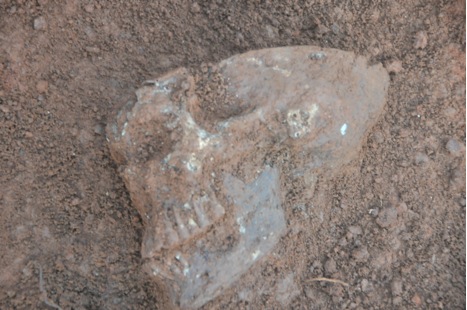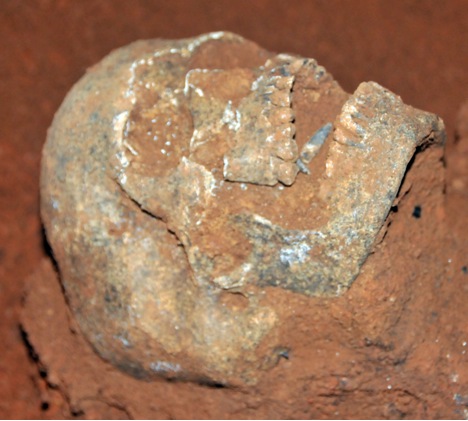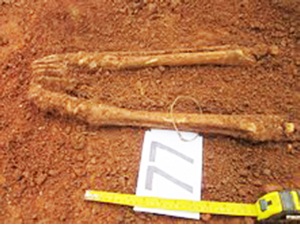Matale Mass Grave: Skeletons In Closets As Well?
By Darshanie Ratnawalli -
The Matale mass grave has had its 15 minutes of fame. From the time when it was first uncovered in November 2012, throughout the judicial inquiry by the Matale Magistrate and right up to the appointment of the Presidential Commission of Inquiry, the media fluttered around it moth like. Recently the mass grave got a definitive date. The news failed to grip.
Wrong news
The only news site to report it, adaderana.lk got it wrong. They reported on 18 November 2014 that the Police informed the Matale Magistrate’s Court that day that the skeletons of the mass grave belong to the early 1950s. In reality the early 1950s don’t come into the picture at all. I reproduce the report below;
“Report on Radiocarbon Analysis of Samples, Matale Case No. B.1810/12, Sri Lanka Douglas H. Ubelaker, PhD Smithsonian Institution Washington, D.C. USA October 30, 2014
This report is in reference to samples submitted to Beta Analytic Inc. for radiocarbon analysis. According to the report from Beta Analytic Inc., these samples originate from skeletons number 27, 50, 81 and 136. For all samples, values of PMC are less than 100 and values of fraction modern are less than 1.0. These values indicate that the samples were formed prior to the modern period (defined as post AD 1950 with the entrance of excess radiocarbon in the atmosphere due to thermonuclear weapons testing). Details of the analysis procedures and specific results are cited in the report by Beta Analytic Inc..”
Pre 1950 mass graves?
The problem with this date is that the forensic evidence on the skeletons; signs of being nailed, buried without clothes, noosed and chained, of decapitation, nonconformity with cultural norms associated with respect to the dead do not match what we know of the pre-1950 socio-political climate of Sri Lanka. How to explain an extra legal mass grave in pre 1950 Sri Lanka? The most plausible hypothesis, a World War 2 death camp maintained by the Allies in the colony of Ceylon, is not borne out by recorded history or legend.

They had a decent burial- The lying posture of the skeletons from the mass- burial at St. Mary Spital London are different from Matale
Forensic Archaeology
Bone fragments were first discovered on 24 November 2012 during earth moving operations in the Matale Hospital premises. The judicial inquiry by the Matale Magistrate started on 26th November. In a letter dated 10th December 2012, Consultant Judicial Medical Officer Dr. Ajith Jayasena asked the Post Graduate Institute of Archaeology to send Professor Raj Somadeva to the mass grave site, which had become a crime scene. The professor went, saw and prepared a forensic archaeological report (full text) on the 154 individual skeletons that were scattered within 97.75 square meters. It was a piled up burial. Two layers.
Anti-cultural burial
It was not what’s known as a ‘decent burial’. The Matale burial postures, we are shown, contrast with the neat coffin postures seen on the skeletons found in the mass- burial at the St. Mary Spital London, probably the legacy of some natural catastrophe such as an epidemic. There are several skulls that remain devoid of their skeletons. It may indicate that such skulls, that is to say heads, had loosened from their body parts before burial. Distilling, the report states: “These four observations urge one to think that there has been no formal mortuary ritual performed during the burial event. It specifically signifies that the intention of offering due respect to the diseased has not been considered so important.”- (p34)
Naked corpses
According to the report “The absence of evidence of any clothes that covered the bodies of those who were meant by corpses at the time of the inhumation is somewhat questionable.”- (p39). The only sign of clothing that can be associated with the skeletons is a button, which Raj Somadeva thinks, on stylistic grounds, was part of female attire. The professor is led to “the inference that those corpses would have been buried without their clothing and the cloths would have been removed merely before burial. I guess that the button that remained is an accidentally fallen object during the quick removal of clothing form one of the corpses.”
Decapitated bodies
Detailing an extra gruesome aspect of the mass grave, the report states; “The upper part of the skull of skeleton number 76 including its parietal and frontal bones has been removed by cutting it using a sharp tool (fig.41). This was not a result of the autopsy examination on the corpse (Jayasena pres. com)… The sharp cut-mark remained has strongly suggested that it is a result of a conscious human action probably the result of an action similar to decapitation.” Another awful observation is that “some of the skulls that remained at the site have lost their full skeletons (eg. no I/G/E/F53/51). No evidence exists to show that this was due to any post-burial disturbance such as the interference by scavenging animals like cadaver-dogs or a result of some anthropogenic disordering. Absence of evidence suggesting post-depositional disturbances urges to infer that the upper part of some of the corpses have been separated before they were buried.”- (p40-41)
Noosed legs
The report describes ‘two peculiar artefact occurrences’ associated with the Matale skeletons that suggest torture. “The association between a noose made out of a metal wire and the leg-bone of skeleton number 77 is unusual. This leg-bone was trapped in the metal noose when it was found. It suggests that this noose was attached to the leg of an individual who represented this skeleton when it was buried. In a comparative sense this metal noose stands for neither jewellery nor any ritualistic amulet within the cultural context in Sri Lanka.”- (p41).
Chained feet
From a place close to the foot of skeleton no.59, six rusted objects that seem to be links of a metal chain were found. They are listed as පැ 06 in the case record of the Magistrate Court and as Object ID – MT/MG/2012/Mo1 (fig. 11) in the Somadeva report. (p17, 18)
Nailed hands
Five iron nails were found associated with the finger bones of skeleton no.6. One of the nails had bone fragments attached at either end suggesting it had penetrated the bones of the palm. Skeleton no. 06-B meanwhile had three iron nails fallen on the ground on either side of its right leg.-(p41)
Pre-1950 or 1986-1990?
When the Presidential Commission of Inquiry was appointed into the mass graves, it was eager to take the investigation forward along channels opened by the judicial enquiry. On 3rd February 2014, M. A. Cyril, Secretary to the Commission wrote to the Inspector General of Police: “It appears to the Commission that the Magistrate Matale has not been able to bring the inquest into the above deaths to a conclusion due to the nonavailability of scientific evidence in order to establish the time period during which these deaths have occurred.”

Did that hurt? An artistic reconstruction of the systemic setting of iron nails into the finger bones of skeleton no.6
Nevertheless, in the forensic archaeological report, a time period had been established: “As suggested by the dates of the manufacture of artifacts, this inhumation has been carried out at a time not earlier than the year 1986 and not later than the year 1990.”- (p47).
Eagerness for radiometry
It’s important to understand that in arriving at this time bracket, the skeletons have been dated relative to the objects found above and below them. The skeletons in the middle have been automatically dated by an archaeologist who was satisfied that it was an undisturbed stratigraphy. Hence an eagerness was expressed by all parties to cross check this relative date through radiocarbon dating. In page 46 of his report professor Somadeva recommended “Radiocarbon Bomb-pulse Method (RBM)… which needs a small sample and has a high degree of reliability to date the forensic materials especially that has a recent origin.”
Drama in Commission
When the radiocarbon test results arrived contradicting the relative time bracket, there was restrained drama in the Commission on 19 November 2014:
Mr. Kitulgoda: …you were not absolutely sure about the opinion you expressed. That is why you requested the Magistrate to have a proper investigation done at Beta analytics USA. Now, today you have received the report of the radiocarbon dating test. Are you inclined to agree with this?
Prof Somadeva: Actually there is no problem because this is an independent report by the Smithsonian Laboratory. It’s a scientific report, so we must accept it. But record this very carefully. Who send the samples and what sort of samples. I clearly stated to the Head of the CID before sending these samples, to be careful because the mass grave was twice submerged by rain water. So, definitely the samples have been contaminated. So, before sending the samples you have to get the advice from a Medical Practitioner that these samples are not contaminated by any exogenic chemical property.
Jayasena vs Somadeva
When I called Dr. Ajith Jayasena to get his take on this contamination issue, he told me that at the time the pit was submerged by rains, the majority of the skeletons were still underground. When I checked this with Raj Somadeva, he agreed. This means that the professor has no grounds for his rather sweeping statement: “So, definitely the samples have been contaminated” What he probably meant in front of the Commission was that since there were some skeletons amongst the 154 that had been exposed to rain water, someone could have collected a contaminated sample if they didn’t know which was which.
Professor’s gripe
In his testimony before the Commission on 19 November, Raj Somadeva’s main gripe (if one may use that term for his professional displeasure) is that the collecting and handling the samples were not done under his supervision. Listen to him;
“So you have to be careful. Samples should be collected by trained people… It has to be done by an Archaeologist. …At least Dr. Ajith Jayasena should collect the samples under the observation of an Archaeologist …Actually, Sir, I advised the officials before sending those samples that you have to get the confirmation of the rate of contamination. Without that the scientific results will be changed. It will come upwards or downwards…You cannot pick a long bone from a skeleton, put to a bag and send to the Beta Analytics …If someone ask me how to handle the sampling procedure as an archaeologist, I will help them how to collect this, what is the procedures and everything. Nobody asked me about that.”
No paper trail
When I asked Dr. Ajith Jayasena what he thought of this stand, he retorted; “Have you read his report? Is any of this mentioned there?” I think that is a fair question. The recommendation to send bone samples for radiocarbon dating came from the professor. He specified to the Matale Magistrate the name of the test, name of the lab, contact details, price range, required sample size and number, even what type of container to use. Any recommendation that samples should be collected and preserved under the supervision of an archaeologist or that contamination levels should be tested is missing from the written record. As an outsider, it seems to me vital in a multi-party investigation to leave a paper trail of your concerns and recommendations because verbal instructions can get lost in the translation or fall by the wayside.
Radiocarbon virgins
“Yes he mentioned that samples may be contaminated. But why is everything verbal?” said Dr. Ajith Jayasena to me over the phone. This question had also occurred to the Commission when they had the professor before them on 19 November.
Prof Somadeva- …It totally depends on chemistry. It should be tested by a chemist and confirm it. So I clearly stated that fact, before sending those samples to the chief of the CID.
Mr. Kitulgoda: Have you stated that in your report?
Prof Somadeva: No, why should I state that in the report? No. I do not want to. I am not involved in doing scientific testing.
I find the professor’s attitude here totally puzzling. Why shouldn’t he state that in the report? Why didn’t he want to? I called him up to ask. “These things are common sense” was his answer. They may be common-sense to a radiocarbon dating veteran like him but apparently the rest of the mass grave team were radiocarbon virgins. “This is the first time we have sent a bone sample for radiocarbon testing”, Dr. Jayasena told me. I asked why he did not get the bones tested for contamination before sending. “We are forensic people. I don’t have the expertise to do that type of test. And such a test wasn’t specified by the lab” said Dr. Jayasena adding that he even asked a reputed forensic scientist about what information to send. “Just the weight of the samples and which anatomical area they came from” were all he was advised to specify. “No, no. There is a separate column in the Beta Analytic Inc. form, asking if the samples have been contaminated en route, etc. They ask this because if there has been contamination they can refine the sample” clarified Prof. Somadeva when I called for the third time. I asked him if he is sure of this as Dr. Jayasena had insisted that the lab did not ask for contamination levels. “Of course I am sure. I filled about six forms to send samples to Beta Analytic just now. Dr. Jayasena wouldn’t have filled the form anyway. It would be done by the CID”. “Did the CID ask you about how to fill the form?” I ask. “No. nobody asked me” says Raj Somadeva.
The Presidential commission of Inquiry into the Matale mass grave has had its final sitting. We await the outing of their report to see what they have made of all this.
*@ http://ratnawalli.com / and rathnawalli@gmail.com








